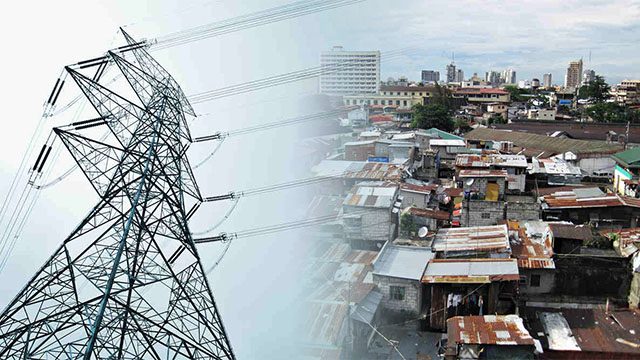SUMMARY
This is AI generated summarization, which may have errors. For context, always refer to the full article.

MANILA, Philippines – Informal settlers have severely hampered the key transmission line projects of the National Grid Corporation of the Philippines (NGCP), the company said on Friday, July 31.
Informal settlers in Quezon City, Caloocan City, Valenzuela City, and San Jose del Monte City in Bulacan does not allow NGCP linemen to enter their properties to conduct line and tower inspection, maintenance, and upgrading activities, despite negotiations and repeated pleas.
NGCP said it legally holds the right-of-way (ROW) in these areas near and around the San Jose-Quezon 230-kiloVolt (kV) transmission line project.
But people unlawfully occupying and residing in areas along the high-voltage lines are making it difficult to implement the line upgrade. The project was originally scheduled to be completed in 2013, NGCP said.
The project aims to prevent possible transmission congestion by putting in place 19 kilometers of lines, power circuit breakers, and associated equipment at NGCP’s San Jose and Quezon sub-stations. San Jose is the main merging point of bulk generation coming from Northern Luzon.
‘Think of the common good’
NGCP identified 23 “workable” tower sites for the line project, but 67 sites were deemed “not workable” and troublesome because of stalled negotiations with the informal settlers.
Of the 67 sites, 10 are already the subject of expropriation cases filed by the company, while 57 are still undergoing negotiations for payment.
There are 1,022 houses and structures along the San Jose-Quezon line. Of these, only 85 households have agreed to payment, and only 24 were relocated.
The rest are in various stages of validation, processing, and negotiations.
Public service
NGCP is a privately-owned corporation in charge of operating, maintaining, and developing the country’s power grid. It transmits high-voltage electricity through “power superhighways” that include the interconnected system of transmission lines, towers, sub-stations, and related assets.
The consortium, which holds the 25-year concession contract to operate the country’s power transmission network, is comprised of Monte Oro Grid Resources Corporation led by Henry Sy J., Calaca High Power Corporation led by Robert Coyiuto Jr, and the State Grid Corporation of China (SGCC) as technical partner.
NGCP stressed that it cannot maintain, let alone upgrade, the line properly with this kind of resistance from the residents. It also repeatedly warned the residents that the breakdown of power transmission structures would result in the loss of bulk power supply to Metro Manila.
“We enjoin the residents to see past their own interests and think of the common good. This is not for NGCP’s benefit or for private gain. The right-of-way in question is for the benefit of a public facility, and the immediate and primary beneficiaries are the electricity consumers in Metro Manila,” NGCP said.
Violating safety clearances is detrimental, not just to NGCP’s technical operations, but also poses dangers to the public.
Electrocution, accidents, and line trippings or outages affecting electricity consumers are some of the negative effects that may arise from the refusal of residents to respect NGCP’s recommended transmission line clearances.
“These accidents may be averted with proper and timely maintenance and correction work. Our regular maintenance activities, as well as expansion and upgrading projects, aim to enhance the reliability and quality of electricity delivered to grid customers.
NGCP added that while it is a private company, it is engaged in public service.
“And it is our every intention to discharge that public service to the best of our abilities. But we need the support of the public to do this,” explained NGCP.
“To begin with, these homes and structures should never have been built so close to, or directly underneath our lines,” NGCP stressed. – Rappler.com
Transmission lines and informal settlers area images from Shutterstock
Add a comment
How does this make you feel?
There are no comments yet. Add your comment to start the conversation.